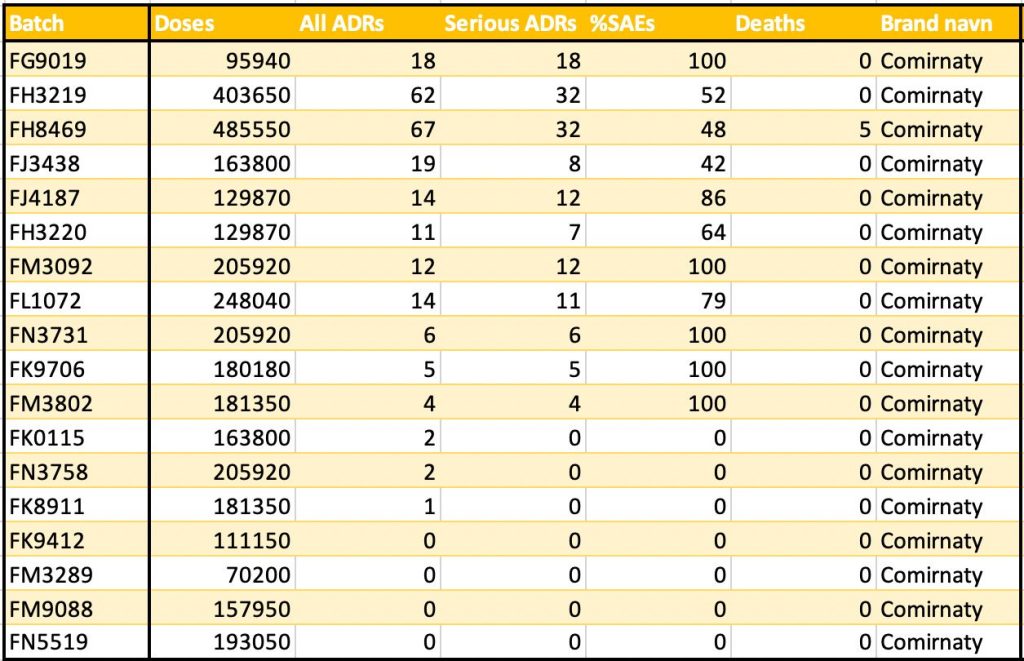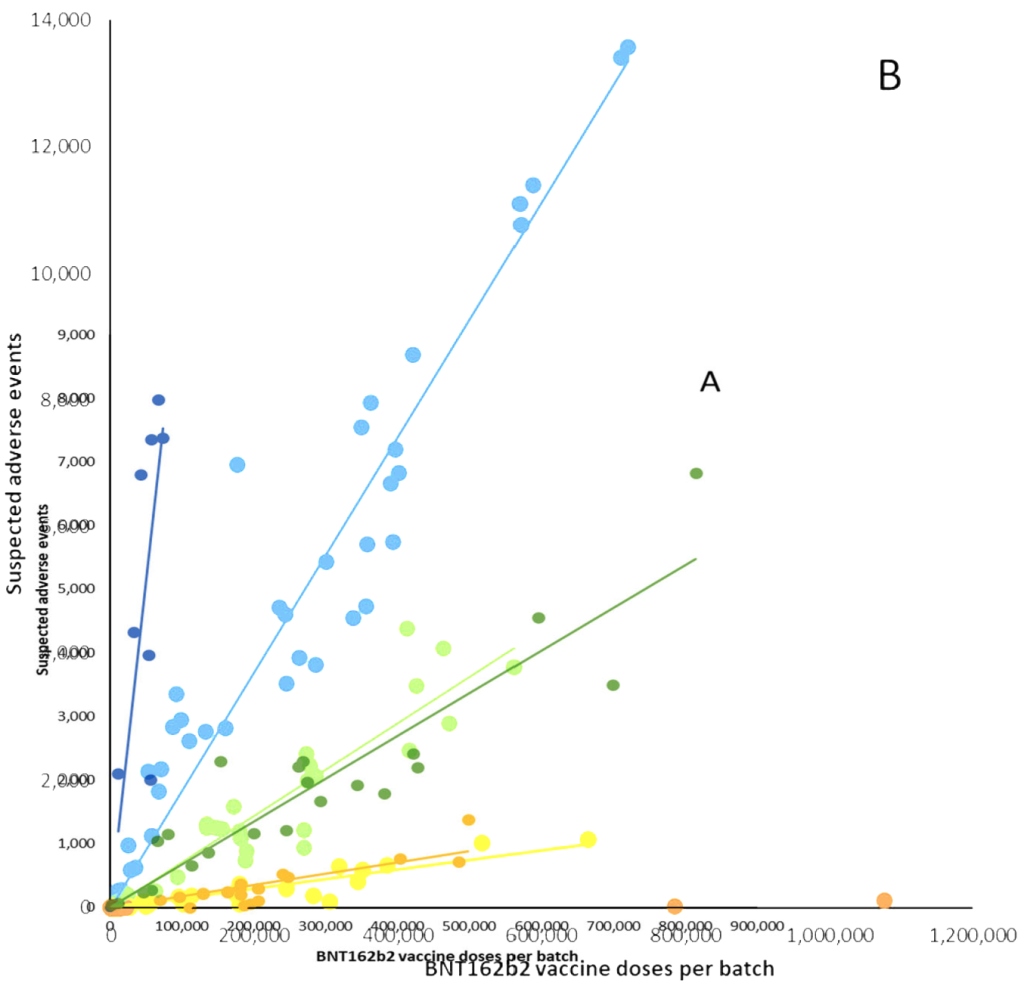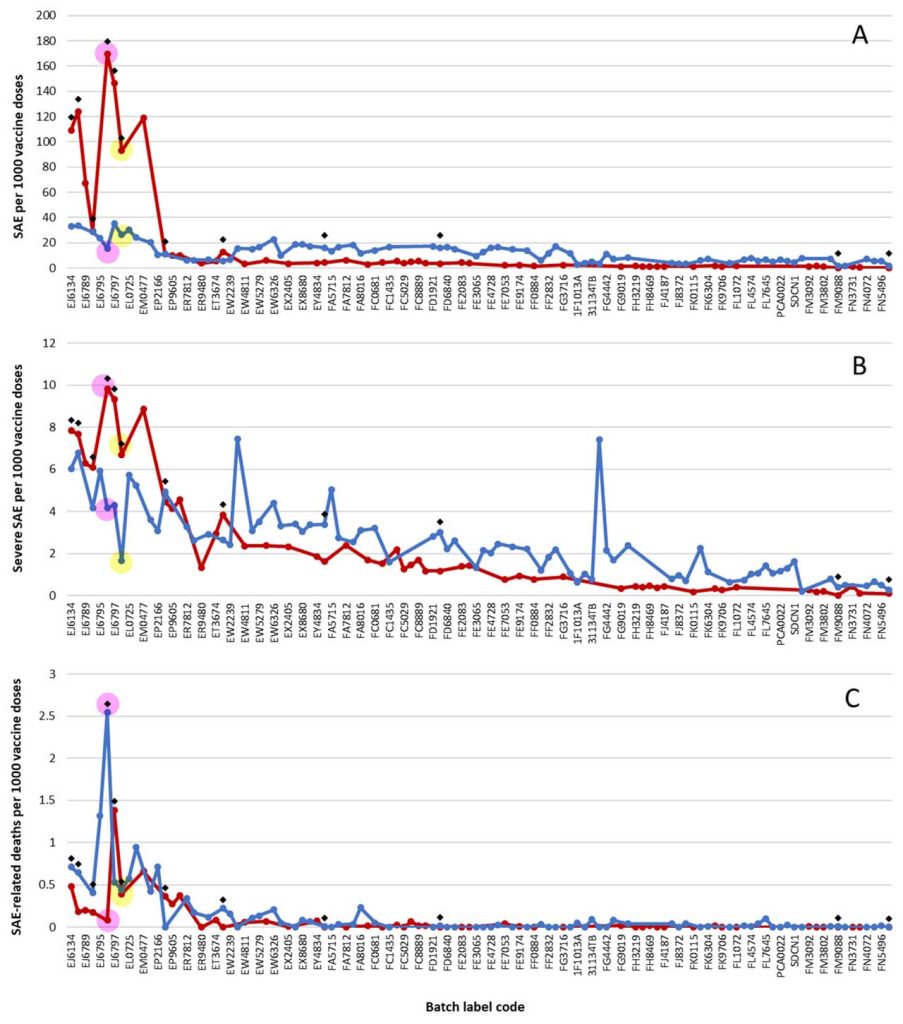In the study Batch-dependent safety of the BNT162b2 mRNA COVID-19 vaccine in the United States analyzes the safety of different batches (lots) of the Pfizer-BioNTech COVID-19 vaccine. We were already familiar with such an approach from Denmark and later Sweden. There appear to be significant variations between vaccination lots in terms of adverse events, including serious adverse events and deaths.
United States
De eerste batches, verspreid in december 2020 en begin 2021, hadden hogere aantallen ernstige meldingen (niet alleen bij hogere leeftijden, ook zorgpersoneel werd daarmee geprikt). Ook werd een mogelijke correlatie tussen fabricagekwesties en bijwerkingen opgemerkt bij bepaalde batches. De analyse werden gedaan op data van meldingsdatabase VAERS.
The reliability of notification databases is low. This is evident once again, but we have nothing better. It is used because the authorities refuse to share information in a meaningful way. Again, we see impossible data. Keep in mind that it was contractually stipulated that governments had to monitor particularly strictly in the context of the emergency permission. After all, these vaccines had never passed a regular inspection. That is why every 'adverse event' after the jab had to be reported, suspected or not. So definitely any death after the jab!
Take a look.
Er waren drie batches zonder een enkele melding van een overlijden. Met het exacte aantal doses (10.530, 15.800 en 63.180, samen 89.510 doses) is de kans dat er binnen één dag helemaal niemand overlijdt ongeveer 14%. Over een periode van zeven dagen is de kans vrijwel nihil (0,000589%). Het is gewoon onmogelijk dat er binnen een of twee weken (of langer) geen enkel sterfgeval zou optreden na deze hoeveelheid prikken. Bij dit aantal prikmomenten verwacht je er normaal gesproken (bij een veilige prik) ongeveer 2 per dag, 26 binnen twee weken, dat is normale sterfte. Maar nu: nul. Melden mensen na die twee weken nog? Als ze vermoeden dat het prikgerelateerd is wel…
Now, underreporting is a well-known problem. Purely based on probability, you could make it plausible with an undercalculation of 1:230 that there are zero reports within 1 week. That's very crude. Let's be mild: we'll make it 1:100. That means we can multiply all the death reports in VAERS by 100 to get an idea of the actual numbers... Let's not do that.
Denmark
We have seen something similar in previous articles about the Danish study1Fate of the bad batches 2Half of the deaths come from 5%... 3Criticism of misinterpretations of Danish research in which the batch variation was discovered. See this table of the 18 'yellow' lots.
In 17 of them, 0 (zero) deaths have been reported. The bottom four, togethermore than half a million jabs, have not produced any reports of an adverse reaction... The bottom seven,more than a million jabs: 4 side effects in total! Impossible.
The third from the top, just under half a million jabs: 5 deaths! Curious, isn't it? That alone is a signal of potential product instability. Or administrative hiccups? Could it be that those batches have not been used or thrown away, and why?
No matter how you frame the underreporting, it will not differ per batch. But there is no doubt that the batches differ from each other. And that 'passive reporting' doesn't work at all. There is also no doubt that this has been deliberately ignored by the health authorities for years. Some industries have such integrity that you don't need prying eyes at all.
We can't break down the information at batch level any further. We only know which vessel it comes from, as one of sometimes hundreds of thousands (even millions) of injections.
The products have never been checked or approved. Only the prototypes submitted for approval have been approved, the intended formula. So that was not the final commercial products. They went through a completely different production process than the prototypes from the lab.
So you sign up for an American hand-built guitar. you get a Chinese factory clone and everyone is fine with it.
This lack of control over the final product and the variability that we already see at batch level do not give reason to assume that the final injections from the same batch had exactly the same quality. The vaccines are not (contractually) 'serialised', so that it is not possible to determine per delivery or even per injection which route they have taken from production. The product is extremely sensitive, so transport and storage methods (refrigeration) can play a crucial role.
Zweden en Denemarken: zelfde batches, ander resultaat
But even within batches, the variety of side effects is different. We see that in this study, which Sweden the aforementioned Danish study Compares.
In this graph, the dark colors are Denmark, the light colors are Sweden. Three groups can be distinguished in both countries. The yellow and green lines correspond in both countries, but the blue lines do not. In Sweden, the 'bad batches' were much less bad than in Denmark.
The argument 'it can't be because of the vaccinations, just look at Sweden' is thus called into question. Differences between countries can be caused by varying quality of vaccines.
There are batch numbers that have been distributed in both Denmark and Sweden. These are the data points in the graph with a black dot above them. They are a bit difficult to distinguish. I marked the data point 4 with pink, the sixth data point with yellow. Look at the differences in values.
The red line is Denmark, the blue line is Sweden.
The top graph is mild side effects, the middle serious, the bottom are deaths.
It goes in all directions, even within one and the same batch number. The same batch therefore produces different results in similar countries.
Czech Republic
In the Czech Republic, they wanted the same research Also run. That didn't work out because the batch number of half of the batches wasn't even registered. However, it can be seen here that the number of reports decreases rapidly during the first few months. I don't even dare to think about the possible administrative problems, if they don't even register the batch numbers.
A mess.
So take comfort: it could always be worse.
Dit was n.a.v. de voorbereiding op een artikel over de oversterfteverschillen tussen België en Nederland.
P.S.: Once upon a time, medicines were withdrawn from the market after a handful of deaths. Policymakers now think differently about civilian casualties, there seems to be a depreciation of the people. But of course, they can't do it alone. Only together can we achieve something. So a little willingness please! You do it for someone else too! Haven't been killed yet? You now have a chance, join us!
(Maybe another booster tip for next year: "vaccination and willingness to die go hand in hand.")
References
- 1
- 2
- 3







I'm going to use 😉 that booster tip for next year (again)
Sometimes you come across someone who makes a surprising remark, such as recently a mother of an adolescent son: "Mine has plus 6 and a half power in his glasses so he is rejected for defense because he never shoots..." Category (also really heard): "I'm keeping my fingers crossed and hope we find good batches because we do want to go on holiday"...
So you know that these people take in information, but the short term is the most important thing, just like most addicts. Weird.
They don't see the implications of the numbers. Reason loses out to Desire.